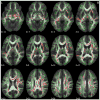Language and reading skills in school-aged children and adolescents born preterm are associated with white matter properties on diffusion tensor imaging
- PMID: 23088817
- PMCID: PMC3631607
- DOI: 10.1016/j.neuropsychologia.2012.10.014
Language and reading skills in school-aged children and adolescents born preterm are associated with white matter properties on diffusion tensor imaging
Abstract
Children born preterm are at risk for deficits in language and reading. They are also at risk for injury to the white matter of the brain. The goal of this study was to determine whether performance in language and reading skills would be associated with white matter properties in children born preterm and full-term. Children born before 36 weeks gestation (n=23, mean±SD age 12.5±2.0 years, gestational age 28.7±2.5 weeks, birth weight 1184±431 g) and controls born after 37 weeks gestation (n=19, 13.1±2.1 years, 39.3±1.0 weeks, 3178±413 g) underwent a battery of language and reading tests. Diffusion tensor imaging (DTI) scans were processed using tract-based spatial statistics to generate a core white matter skeleton that was anatomically comparable across participants. Fractional anisotropy (FA) was the diffusion property used in analyses. In the full-term group, no regions of the whole FA-skeleton were associated with language and reading. In the preterm group, regions of the FA-skeleton were significantly associated with verbal IQ, linguistic processing speed, syntactic comprehension, and decoding. Combined, the regions formed a composite map of 22 clusters on 15 tracts in both hemispheres and in the ventral and dorsal streams. ROI analyses in the preterm group found that several of these regions also showed positive associations with receptive vocabulary, verbal memory, and reading comprehension. Some of the same regions showed weak negative correlations within the full-term group. Exploratory multiple regression in the preterm group found that specific white matter pathways were related to different aspects of language processing and reading, accounting for 27-44% of the variance. The findings suggest that higher performance in language and reading in a group of preterm but not full-term children is associated with higher fractional anisotropy of a bilateral and distributed white matter network.
Copyright © 2012 Elsevier Ltd. All rights reserved.
Figures






References
-
- Allen MC. Neurodevelopmental outcomes of preterm infants. Current Opinion in Neurology. 2008;21(2):123–128. - PubMed
-
- Anderson P, Doyle LW, Callanan C, Carse E, Casalaz D, Charlton MP, et al. Neurobehavioral outcomes of school-age children born extremely low birth weight or very preterm in the 1990s. JAMA: Journal of the American Medical Association. 2003;289(24):3264–3272. - PubMed
-
- Andersson JLR, Jenkinson M, Smith S. Non-linear optimisation FMRIB Analysis Group Technical Reports. TR07JA1. Oxford: University of Oxford; 2007a.
Publication types
MeSH terms
Grants and funding
LinkOut - more resources
Full Text Sources

